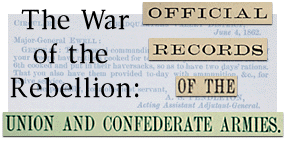Summary:
Brig. Gen. Armistead L. Long was a member of the Second Army Corps of the Army of
Northern Virginia which included the Staunton Artillery. Long reports that the
artillery had a hard time in the dense wilderness but succeeded in firing on the
advancing enemy.
AJDT. Gen., Lieut. Gen. EWELL'S COMMAND, Richmond, Va.
STAUNTON
November 25, 1864
MAJ
I have the honor to submit the following report of the operations of the artillery of the Second Corps from May 4 to 31, 1864:
I received orders on May 4 from Lieut.-Gen. Ewell to move my artillery to the front. I immediately broke up my grazing camps in the neighborhood of Gordonsville, and directed Col. Brown to move his division of artillery in the direction of Locust Grove. Cutshaw's battalion was ordered to report to Col. Carter, who had been ordered some days before the vicinity of Raccoon Ford with Page's battalion, of his division. Nelson's battalion had been some time on the front operating with Early's division of infantry.
On the 5th all my artillery was concentrated at Locust Grove, on the old turnpike from Orange Court-House to Fredericksburg, in the immediate vicinity of the infantry of the Second Corps. On reporting to Gen. Ewell I learned that the enemy was in his front. Maj. Gen. Edward Johnson's division of infantry was advanced, accompanied by Nelson's battalion of artillery. After moving a short distance the division was deployed across the pike, and one battery (Milledge's) was put in position to the right of the road in
CHAP. XLVIII.] RAPIDAN TO THE JAMES. PAGE 1085 [Series I. Vol. 36. Part I, Reports. Serial No. 67.]
front of Jones' brigade. The enemy attacking while the position of this brigade was being changed, it became necessary to withdraw Milledge's battery. After a very spirited attack the enemy was repulsed with considerable loss. Gen. Ewell then took up his position without further opposition. His line extended on each side of the turnpike, the road passing through the center of his division. The right wing was nearly at right angles to the pike, and the left wing was bent back to cover the road leading to the Germanna plank road. The country was of such a character (being a dense wilderness) that but few opportunities offered for the effective use of artillery; nevertheless, a portion of Nelson's guns were posted on a commanding ridge, with a small field in front, immediately on the road, 1 mile from the Lacy house. Two others of Nelson's guns were placed on the road leading to Germanna Ford, to operate with the troops of the left wing of the corps. The artillery during the day was several times used with effect in repulsing partial attacks of the enemy. For the better service of the artillery, our line being quite extended, I directed Col. Brown to take charge of that portion posted on the right of the turnpike, and Col. Carter that on the left. Early on the morning of the 6th Col. Carter was directed to concentrate as many guns as could be spared on the left of our position, which was a good deal exposed, and the enemy was feeling in that direction as if intending to attempt our flank. These guns, with a small infantry support, sufficiently protected this point. During the day the enemy made an attack on Gordon's brigade, which was on our extreme left. Some of these guns were used with considerable effect in assisting to repel this attack. Early in the day Col. Brown, while selecting a position for a battery, was shot by a sharpshooters and instantly killed. His loss was deeply felt throughout the whole army. He not only exhibited the highest social qualities, but was endowed with the first order of military talents. On every where he was called to act he was distinguished for gallantry and skill. The artillery will ever remember him as one of its brightest ornaments. Nelson's battalion was relieved during the day by guns from Lieut.-Col. Hardaway's and Maj. Cutshaw's battalions, Cutshaw occupying the position on the right of the pike, and Hardaway that on the Germanna road. Lieut.-Col. Braxton's battalion was put in position on our extreme right, filling the intervals between Rodes' right and Hill's left. A few guns were distributed along Rodes' front.
Being absent from my command, I am unable to append a list of casualties. The chief loss was upon the capture of Custhaw's and Page's battalions on May 12.
This report would have been submitted at a much earlier period had it not been for the difficulties incident to an active campaign in getting sub-reports, and my own lines.
I am, very respectfully, your obedient servant,
A. L. LONG, Brig.-Gen., Chief of Artillery.
Bibliographic Information : Letter Reproduced from The War of The Rebellion: Official Records of the Union and Confederate Armies, Series I., Volume 36. Part I, Reports, Serial No. 67, Page 1084, Broadfoot Publishing Company, Wilmington, NC, 1997.

